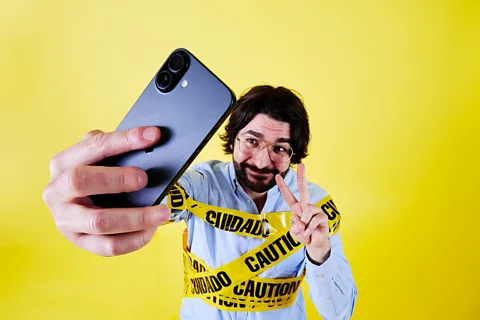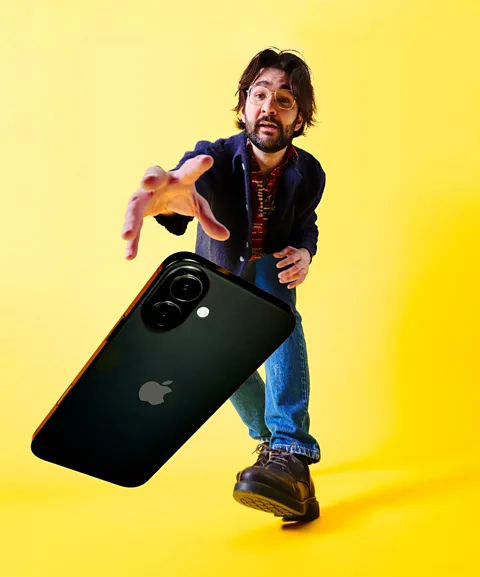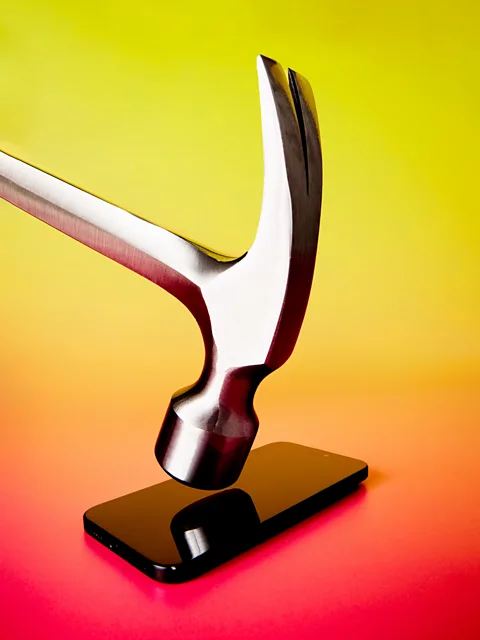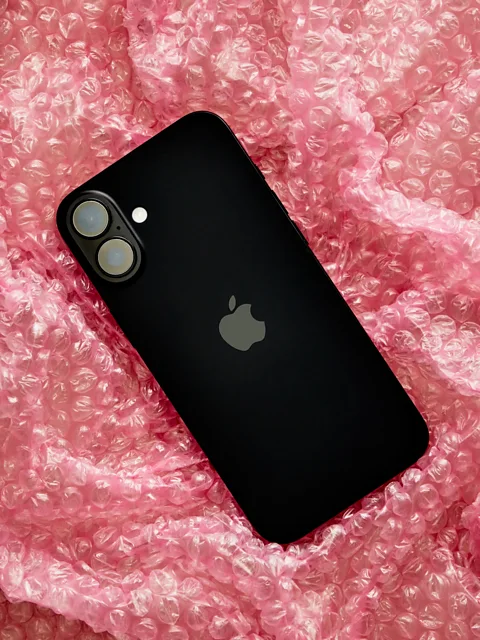Is it finally safe to ditch your phone case? I put it to the test
 Isa Zapata
Isa ZapataWith smartphones tougher than ever, a new wave of phone minimalists say cases are for cowards. I joined the case-free cult, called the experts and braced for the sound of broken glass.
A few months ago I walked into an Apple store to buy a new iPhone. After sifting through models and upgrades, a cheerful salesperson told me the price came to $1,199 (£919). She laughed when I mentioned that's close to what I pay for a month's rent. "Crazy, isn't it?" she said. "Now let's look at some phone cases."
It felt like the obvious next step. But even as the cost of mobile phones breaches the stratosphere, some seemingly reasonable consumers going a different route: they're walking around with their phones completely naked, moving through the concrete and the spills and the dust with no case, no screen protector, nothing. I know some of these people. Their phones are shiny, with titanium frames and carefully engineered glass on full display. They seem so happy and carefree. Is it all in my head? Is fear the only thing standing between me and case-free bliss?
"Come on man, just check out how this thing feels," a friend said to me couple of weeks later. A proud no-case guy, he handed me his iPhone. It was far more handsome without a case, and even better to hold. "They build phones tougher now. I drop it all the time, it's fine."
 Isa Zapata
Isa ZapataAccording to conversations I've had since then with glass manufacturers, die-hard anti-casers and people who get paid to damage phones on purpose, it seems he could be right. Experts agree: the modern smartphone is far more robust than its ancestors. Still, most people I know use protection. So who's the crazy one here?
I decided to find out. When I got home, I tore the case off my phone, threw it in a drawer and committed to a month of sweating through the case-free lifestyle. I pitched my editor a story about it. He liked the idea but assured me the BBC would not pay for repairs if my experiment goes sour. May God have mercy on my soul.
Shattered glass
There's been a lot of discussion about how going caseless has become a status symbol for some who want to give off an air of class and confidence. When I interview tech executives and entrepreneurs, for example, phone cases are a rare sight.
"You're saying 'I can afford to replace this'. But it's not about appearances for me. I was a no-case guy even before my first startup," says Yousef Ali, chief executive of Blast Radio, a live audio platform for DJs. "For me it just seems nuts to have a $1,000 [£766] luxury device known for its material design and spend your day touching a $30 [£23] plastic case instead. It's like putting a vinyl cover on your couch to save the fabric. I have expensive pants too, should I wear an extra pair of pants to protect them? Where does it end?"
I won't pretend the first week without a phone case didn't leave me feeling, well, kind of cool. It's the lamest possible version of flirting with danger. But trends come and go. What I want is facts – ideally some harder than the ground I picture my phone careening towards.
If you're reading this on a mobile phone, you're probably looking through Gorilla Glass, a patented, smash-resistant technology made by a company called Corning. All the big-name phone manufacturers use Gorilla Glass or another Corning product for some or all of their screens, including Apple, Google, Huawei and Samsung. There are some exceptions for older phones and budget brands, but for the most part, Corning has the market cornered.
The Gorilla process starts with dipping glass in a bath of molten salt heated to 400C (752F). "The bath pulls smaller ions such as lithium out of the glass and swaps in larger ions such as potassium," says Lori Hamilton, Corning's director of technology for Gorilla Glass. "It creates this layer of compressive stress that makes it more difficult for flaws to penetrate through the glass." In other words, it squishes the glass together, making it less susceptible to damage.
Corning's research involves putting phones through ritualistic torture to study what goes wrong and how to prevent it. Phones face special glass scratching machines and go into tumblers with car keys to simulate pockets. Corning even collects phones busted by consumers in the wild to find unusual damage.
 Isa Zapata
Isa Zapata"Then we go through a CSI-type effort called fracture analysis, where we study tiny shards of glass to understand the source of the original fracture," Hamilton says.
When your phone breaks, it's the screen that fails most of the time. But according to Hamilton, results have improved dramatically in recent years, and today's smartphones are far stronger. In 2016, Corning reported that Gorilla Glass 5 survived drops of 0.8m (2.6ft) in the lab. That grew to 2m (6.6ft) with Gorilla Glass Victus in 2020. Gorilla Armor 2, one of Corning's latest products featured on the Samsung Ultra S25, has reportedly braved up to 2.2m (7.2ft).
Outside evidence seems to back up these improvements in phone materials, construction and design. In 2024, the insurance company Allstate, which sells phone protection plans, found that 78 million Americans reported damaging their phones, compared to 87 million in 2020.
"We don't use the term unbreakable," says Hamilton. "There will always be failures. There are always situations where you get a deep enough flaw or the right kind of bending." But Hamilton says skipping a case is reasonable, and at this point it's just a matter of preference. "After all, phones are an investment," she says. "I don't use a screen protector, but I actually do use a case." It's not for safety, though. It's a wallet case. "I just like a place to put cards and money."
'It's made me more conscious of the thing'
Gorilla Glass was invented for the iPhone, though the latest models use a similar but upgraded Corning glass technology called "Ceramic Shield" made with "nano-ceramic crystals". Apple claims the latest iteration of Ceramic Sheild for the iPhone 16 makes it "2x tougher" than the glass on any other smartphone.
You might think those crystals and ions would be enough to shield me from spending money on a phone case, but manufacturers send mixed messages.
Apple will sell you on the wonders of ceramics, but is also happy to sell you a case stamped with the Apple logo. My iPhone salesperson suggested I might like a nice blue one for $49 (£38). So, does an iPhone need a case? Apple wouldn't say: a spokesperson declined to comment.
Phone case manufacturer Spigen, on the other hand, was happy to talk. "It's true that phones are more durable than ever," says Justin Ma, a Spigen spokesperson. "However, despite these advancements, these devices are always prone to accidents," he says.
But even Ma wouldn't call a case necessary. "You might expect us to say everyone needs a case. But the reality is that it depends on the individual." Some people like the feel of a bare phone, some want maximum protection and still others choose a case for aesthetic purposes.
Whatever their reasons, case users are a massive contingency. Ma says Spigen cases alone cover 100 million devices. The consulting firm Towards Packaging clocked the global phone case market at almost $25bn (£19bn) in 2024.
I was standing in my kitchen drinking a glass of water when I got the itch for one last bedtime doomscroll. As I yanked my phone out of my pocket, my fingers slipped. My pristine iPhone made a ferocious arc through the air, bounced off the side of my refrigerator and landed hard, corner first, by my feet.
But when I checked, my phone was fine, saved perhaps by hardened glass, dumb luck or my gentle linoleum floor.
For Jonna Valente, one half of a caseless couple based in North Carolina in the US, going without a case wasn't about science or status. "When I got my last phone, my daughter picked out the pink colour, and I didn't want to put a case on it because she just loved it so much," she says.
Valente never looked back, and as time went by, she realised living without a case changed her relationship with her phone. "Because my fingers don't grip it as well, I just have more of an awareness," she says. "It's made me more conscious of the thing, and I find I don't get blindly sucked in as much as I used to. I can't believe I'm saying this but I think I'm actually using my phone less."
As romantic as Valente makes it sound, I can't say the same. I'm as mindlessly glued to the internet as ever before.
The drop
Early in my career I worked at the magazine Consumer Reports, which has a full-on laboratory where teams of engineers have designed scientific tests to rate and review the products for almost 90 years. Just down the hall from my office was a crew that has rated phones for decades. To test for durability, Consumer Reports uses violence. If anyone knows the truth, it would be my old colleague Rich Fisco.
"We call it the drop test," says Fisco, who heads Consumer Reports' electronics testing. Phones go into a three-foot-long metal box with concrete panels at both ends, he says. Then the box spins, 50 times, slamming the phone against the concrete again and again. When the process is over, an engineer examines the device. If it survives, Fisco says they put the phone back in the box and give it yet another 50 drops.
 Isa Zapata
Isa Zapata"When the drop tests first started, about a third of phones would fail," says Fisco. "We haven't seen a phone fail the drop test in a long time. The glass has improved. These days they seem to be doing a lot better," he says.
"Look, I'm not saying the screen won't get scratched at some point, and if you drop it just right, or it lands on a little rock, say goodbye. But if your phone falls out of your hip pocket when you're walking down the street, the reality is it's probably not going to break," Fisco says. "It's true, you don't have to use a phone case anymore. But the real question is, are you a gambler?"
Even though Fisco publishes results that show dozens of phones passing the drop test every year, he still keeps his own device wrapped in a case. "Of course I do," he says. "I'm cheap."
I was rushing out the door on day 26 of my month with no case. Standing at the top of my building's staircase, I grabbed my phone to check on my commute to work. The next moment is a blur – I was probably being careless – but suddenly my phone was not in my hand but, in fact, tumbling out in front of me. I winced as it bounced down the steps once, twice and three times before clattering to a stop at the foot of the stairs.
I rushed down to rescue it, and lo and behold, there was a small gash in the corner of my iPhone's aluminium siding. The glass, however, was miraculously unscathed.
I spent the remaining days of my experiment playing it safe, clutching the phone tight on my rides on the subway, practicing mindfulness whenever I picked it up or set it down and on the whole simply using the thing a bit less.
More like this:
• Inside YouTube's world of forgotten videos
My friend, on the other hand, wasn't so lucky. The next time we met up in the park, I asked him how his phone was doing. "Bad," he said. "I dropped it. It's smashed, cracked, the front and the camera lens." He was the first to call it ironic. Then again, he has an older iPhone. Maybe the newer ceramic glass would have saved him. Maybe not.
No matter how many salt baths they give your screen, glass is breakable. But I'm now convinced that with newer devices – and steadier hands than mine – a case really is optional if you're willing to accept some very real risks. By the end of the month, though, my nerves were shot. I'd been walking a tightrope, and while I'd survived a lot of bumps and drops, every near miss felt like a warning.
In the end, I'm back on the case. But every once in a while I still slip it off, just for the thrill, and let my phone feel the wind in its glass.
* Thomas Germain is a senior technology journalist for the BBC. He's covered AI, privacy and the furthest reaches of internet culture for the better part of a decade. You can find him on X and TikTok @thomasgermain.
--
For timely, trusted tech news from global correspondents to your inbox, sign up to the Tech Decoded newsletter, while The Essential List delivers a handpicked selection of features and insights twice a week.
